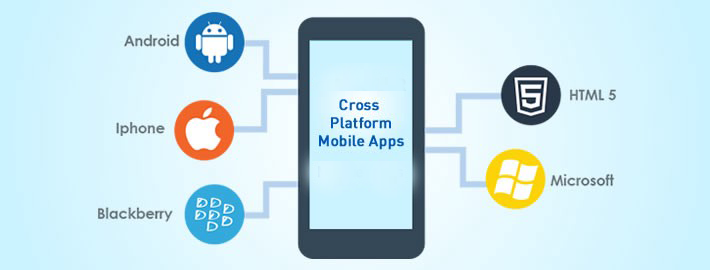Through the years, cross-platform mobile app development has gained a reputation as one of the most renowned trends in software development.
This comes as no surprise because the demand keeps growing every single day. In the highly riotous mobile app development environment, business organizations would not risk missing their presence on the Apple App Store and Google Play Store.

Nonetheless, budgeting usually is a concern if organizations go for native applications.
Cross-platform application development, therefore emerged as the unparalleled choice of organizations, intending to have a presence on Android and iOS.
What a Cross-Platform Framework is?
Cross-platform development frameworks let developers build applications for mobiles that are compatible with not just one OS but several operating systems.
It provides the ability of writing code only once and runs it anywhere for other platforms. Therefore, it enables releasing software or product in a safer, faster and high-quality way.
Distinguishing Native & Cross-Platform Development
It’s a never-ending argument, native and cross-platform development. It has kept the tech world divided for some time. Some experts choose native apps instead of cross-platforms.
On the other hand, companies such as Uber are using a cross-platform app to rewrite their driver application.
Today, everybody knows that applications created with cross-platform frameworks ships only if the quality is compromised.
However, nobody measured if they save time over just half of two native applications. Their changing nature signals that the topics must be revisited regularly to check which option is leading the game at present.
The Pros Of Cross-Platform Application Development
Given the huge increase in the expense associated with per platform development, as well as the need for fast market time, cross-platform development is the way to go for an organization. The platform is gaining ground, providing much better benefits.
1. Speed
Using a single code base across numerous platforms helps lower the development efforts around 50-80 percent across projects. It allows the team of developers to adhere to project deadlines.
2. Reusable Code
Development teams need not write unique code for the various platforms with cross-platform as well as hybrid app development.
Rather, the program built for one application is leveraged several times. The codebase is used for future projects.
3. Lower Costs
In mobile apps, internet marketing is considered as the future. Furthermore, the cost of app development across platforms sometimes is prohibitive thus discouraging organizations.
Using one codebase across platforms will result to considerable reduction in cost. Even the development team need not invest money and time in learning several technologies. They need to master a few skills to get started.
4. Easier Maintenance, Deployment
Because only one code is developed, which runs on all platforms, it’s easier to maintain and deploy code or the changes made to it.
Updates could be synced immediately over all devices and platforms, saving not just time but money as well. Furthermore, should a bug be found in the common codebase, it is fixed only once.
5. Seamless Cloud Integration
Cross-platform applications are thoroughly compatible and could benefit from the different plugins integrated with the cloud.
Simply put, a single source code is coordinated with the different extensions and plug-ins to boost the functionality and scalability of an app.
6. Uniform Design
Users acknowledge UI elements, and forecast interactions over different platforms. Thus, the UX or User Experience is one thing to take into account for any software or application. Syncing different projects while developing several apps is not easy.
There are however cross-platform mobile app development tools that let developers as well as designers craft a uniform User Experience that users enjoy.
The Top Cross-Platform Frameworks
There are several cross-platform frameworks available, each with their pros and cons. The following are among the top-performing and competitive frameworks in the market nowadays.
1# React Native of FB
Launched in 2015 by Facebook, it has truly caused quite a wave in the hybrid frameworks market. Within a few years, already it’s one of the most popular and the most trending frameworks in the world.
Pros:
- Besides reusability of code, it also lets you view results immediately, aside from offering ready-to-apply elements, significantly shrinks the development time.
- 80 percent shareable codebase across platforms, which depends on complexity.
- Provide access to specific great native functions such as camera and accelerometer. The result rendered is a native-like UI with high quality.
- Focus on UI to a great extent, resulting in an interface that’s highly responsive.
- Hot reloading feature, which lets developers see changes done in code in seconds instead of minutes.
Cons:
- It lags behind native platforms at times since it’s not built in conjunction with Android or iOS.
- Not completely a cross-platform framework. It requires using native components to be able to use functions such as accelerometer or camera, so there’s a separate code for Android and iOS.
- Deficient consistency in terms of updates release.
- Boosts the development speed, but increases the debugging process duration as well, particularly on Android.
2# Xamarin App Framework
An independent cross-platform development framework launched in 2011. Later however it was acquired by Microsoft, lending more credibility to it.
It’s an open-source framework to solve the concern on disjointed native tech stacks, which made the development of mobile apps costly and difficult.
Pros:
- Has a robust community of more than 60,000 contributors from over 3,700 organizations.
- It seamlessly works on several platforms because it uses C# for coding.
- Faster development with one tech stack.
- Share over 75 percent of code across platforms for ease on ‘write once, run anyplace’.
Cons:
- For apps that require heavy graphics, it’s not recommended. This is because each platform has a different way of laying out screens visually.
- For organizations, it’s expensive. It’s free for startups and individuals but requires organizations to purchase a license for Visual Studio.
- Offers limited access to specific critical libraries that developers require for development. Furthermore, since the core of the UI-creation is not mobile, the creation of a user interface takes time.
3# Flutter
Another free and open source cross-platform app framework for building native interfaces for both iOS and Android.
Flutter is one of the top three most beloved frameworks nowadays, adding another complexity to the current popularity of React Native.
Pros:
- Ideal for the developing MVP. Rather than spending more time and money on two separate applications, you could create a mobile app fast that appears native on both iOS and Android.
- A hot reloading feature letting developers see the changes done in code within seconds.
- Has a full set of widgets in the Material Design of Google as well as in the style of Apple with a Cupertino pack.
- Dart-based, an object-oriented programming language that makes it easy for app developers to acquire a skill for.
- Several ready-made solutions for native iOS and Android apps allow working with continuous integration platforms, such as Jenkins and Travis for instance.
Cons:
- Although developed by Google, there are libraries containing functions that are ready-to-implement. However, it still lacks native development.
- Limited TV support with applications created on Flutter. Has no support for Apple TV and Android TV.
- Since it makes use of in-built widgets rather than platform widgets, thus the the application’s size is bigger. Presently, the smallest possible application created with Flutter weighs not less than 4MB.
Read Also:
- Top 5 App Development Platform for Small Business
- 9 Mobile App Development Tips For Beginners
- App Top 10 Transformative Android Apps Development Trends
Author Bio: Charles Richard is a Business Analyst at TatvaSoft UK. Besides his profession, Charles likes to share some new and trending technical aspects. To know more about his leading mobile app development company based in London, please visit Tatvasoft.















